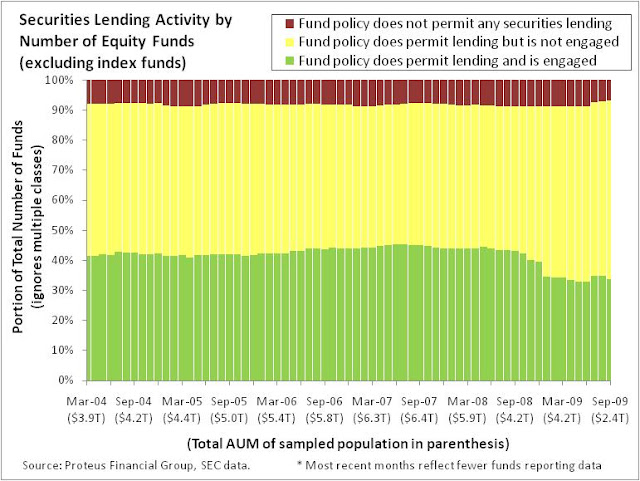On Jan 27, 2010, the SEC adopted a new set of rules governing how registered money market funds operate. A number of these rules were adjustments to certain requirements already existing under Rule 2a-7. While the new rules are material changes relative to current requirements, they might not sufficiently address the root causes of some challenges still facing the money market fund industry.
After the Reserve Fund broke a buck shortly after Lehman Brothers filed for bankruptcy, the SEC and investors have been concerned about the perceived safety of money market funds. The Treasury was concerned enough to create the Temporary Guarantee Program, highlighted in an earlier [post]. The SEC has debated how to change the rules governing these funds. Floating the $1.00 NAV price has been a consideration, but the fund industry's resistance and concerns from that idea have prompted the SEC to focus on other adjustments to the rules.
There are some interesting restrictions on credit quality and maturity of underlying investments. Highlights from the SEC's [summary] of the new rules:
1. Restrict the maximum weighted average maturity ("WAM") of the total portfolio to no more than 60 days, versus the previous limit of 90 days.
2. Limit illiquid securities (those which cannot be liquidated or disposed of within seven days at carrying value) to no more than 5% of total fund assets, versus the previous limit of 10%.
3. Highly liquid securities, which must be convertible into cash within one day and one week, must be no less than respectively 10% and 30% of total fund assets.
4. Limit investments in Second-Tier Securities (generally rated A-2/P-2) to no more than 3% of total fund assets, versus the previous limit of 5%.
5. Limit the maturity of any Second Tier Securities to 45 days, versus the previous limit of 397 days.
6. "Know Your Investor" procedures require money market funds to anticipate potential redemption requests based on the type of investors and past investor behavior.
In essence, all of these requirements seek to ensure that money market funds will be able to accommodate a spike in redemption requests. The Reserve Fund scenario seems to be the case study to which these new requirements are targeted. New monthly disclosures to the SEC, made public with a 60 day lag, will put more pressure on portfolio managers to follow these new rules with a high degree of certainty. As a
result, a portfolio manager might target a WAM which is comfortably under 60 days.
However, one consequence of these rules could be a drop in demand for commercial paper maturing beyond 60 days and other short-tenor bonds which otherwise would cause the fund's WAM to exceed 60 days. This penalty for tenor comes at a time when many corporations, including banks, rely heavily on investors to restructure and rollover maturing debt. More frequent maturing of commercial paper will result in reduced flexibility for corporations to manage their interest expenses. As interest rates rise, as most likely they will over time, corporations and government agencies might need to re-issue short-term debt more frequently and at higher rates.
Should a crisis in confidence or some other major credit event occur, bond issuers will have less time to address their refinancing needs. During a major market crisis, an additional 30 days (difference between a 90-day to 60-day maximum WAM) can be instrumental to survival. Ironically, one firm's inability to survive a liquidity crisis prompted the debate which resulted in these new requirements.
How do money market funds currently manage the WAM in their portfolios? Should we expect a major change in behavior as a result of the new rule?
Specifically with respect to the new WAM requirement, the SEC appears to have implemented a minor tweak in reality. The graph below shows historical WAM as reported to the SEC by registered money market funds, which generally invest in short-term bonds (those maturing within one year). Since past disclosures to the SEC are semi-annual (future disclosures to the SEC will be monthly), the graph shows a six-month historical rolling average which tries to capture the WAM for the entire population. However, there are still variations in WAM during the interim months of the semi-annual reporting periods which may cause these averages to lag reality somewhat.
According to this data, a large majority of money market funds appear to manage their portfolios to a WAM under 60 days. At least 75% of the population (red line), measured in terms of assets, would appear to not be impacted by the new restrictions on maximum WAM. Even the 10% tail of the population (yellow line) with the highest WAM appears to require only some minor adjustments to their future investments. The median (green line) consistently maintains a WAM of under 50 days.
Will these historical norms of managing investments in money market funds be sufficient to meet the financing needs of corporations and government agencies? When markets were more favorable, many issuers found better pricing in the intermediate-term and long-term bond markets. Since the latter half of 2007, issuers facing financial difficulties have been forced to rely more on the short-term bond market than desired. Hopefully, those issuers are not relying too much on registered money market funds to rollover their debts, or else they may want to revise upwards their interest expense projections.








